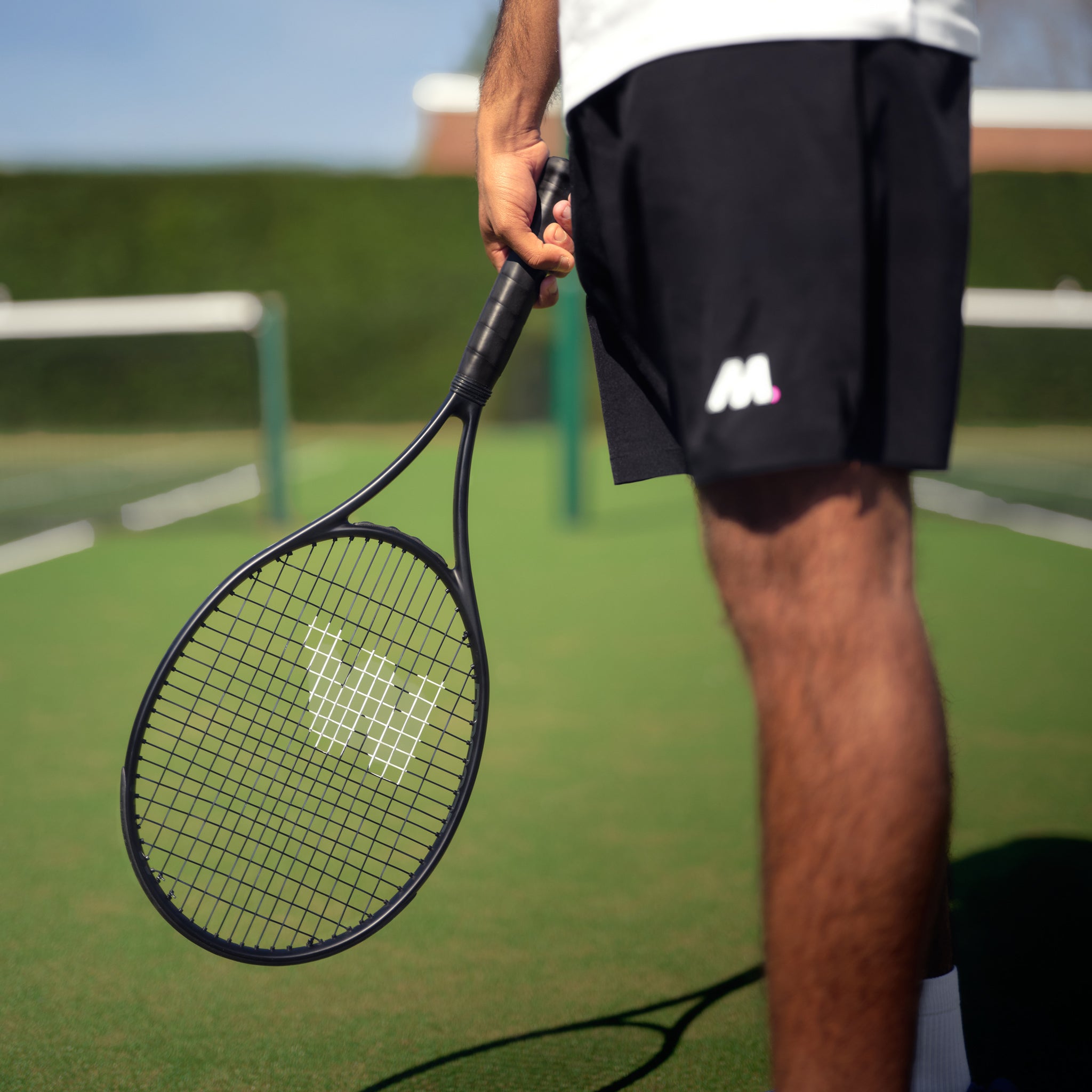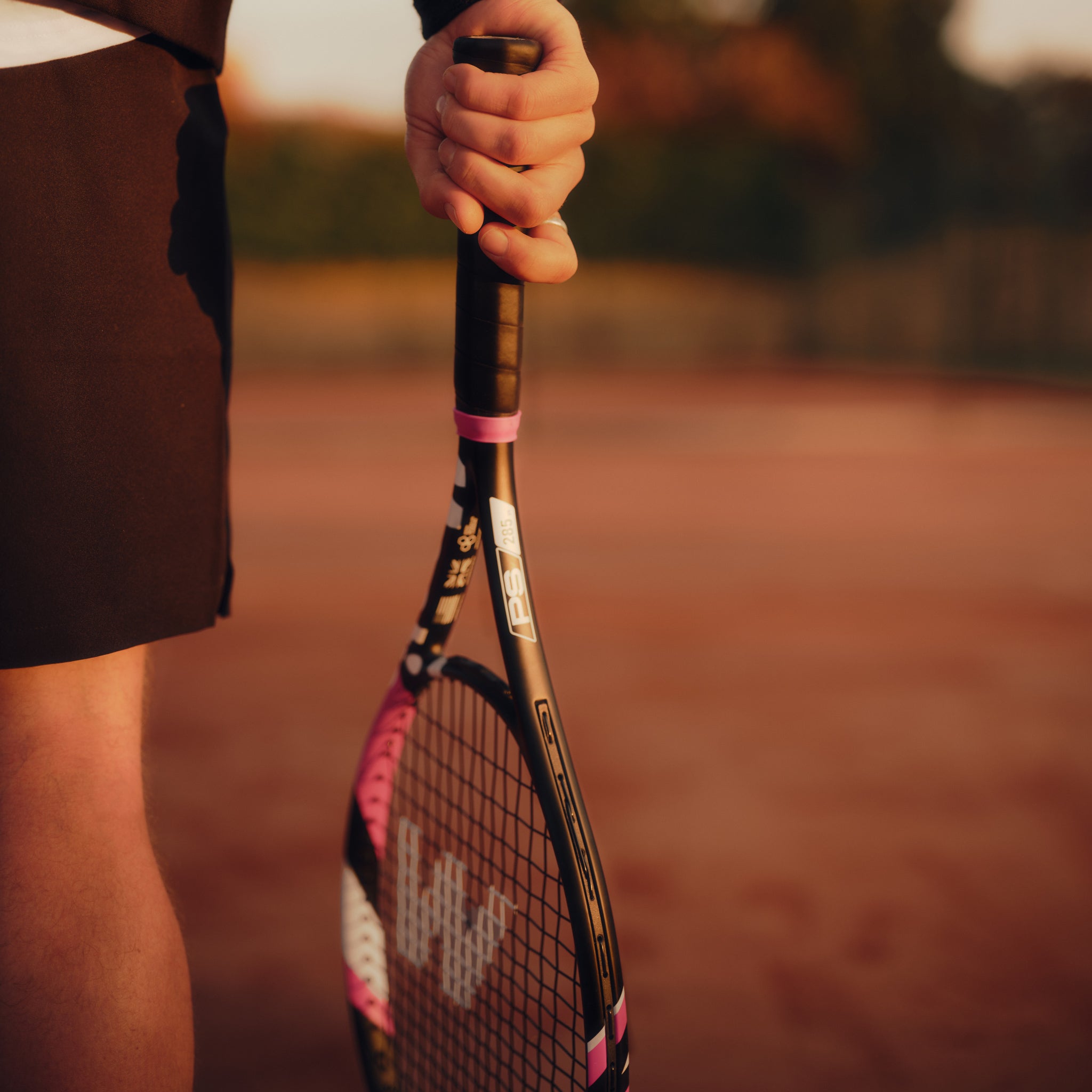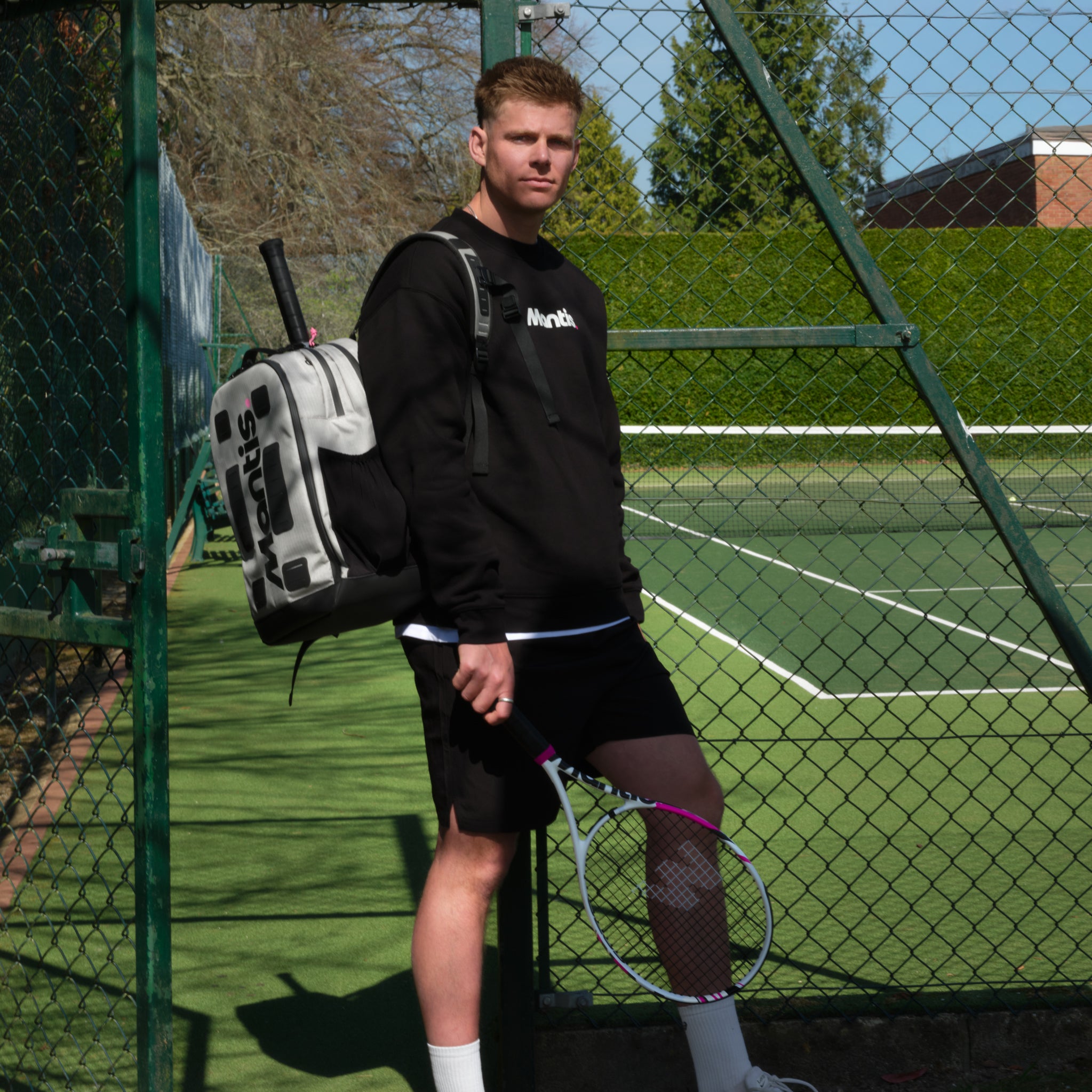
To really get why today’s carbon fibre tennis rackets are so special, you have to look back at the journey from the clunky, unreliable frames of the past to the high-tech gear we use now. The story of tennis isn't just about how playing styles have changed; it's about the evolution of the tools themselves. Here at Mantis, we're obsessed with that evolution, which is why a quick look at our extensive range of tennis rackets shows a deep commitment to performance materials. The move away from traditional materials wasn't just a fad—it was a crucial leap forward, driven by the relentless search for a competitive edge.
Why Carbon Fibre Dominates Modern Tennis
The story of the modern racket really starts with what its predecessors couldn't do. For decades, players made do with wood rackets. While iconic, they were seriously flawed. They were heavy, would warp in changing weather, and had a tiny sweet spot.
What did this mean on court? It meant you had to use sheer muscle to generate any real power, and consistency was a constant battle. Hitting the ball just a fraction off-centre sent a jarring shock up your arm and killed your control. The very nature of wood was holding players back.
The Search For Superior Materials
When metal frames—mostly aluminium and steel—arrived in the 1970s, it was a big step up. These rackets gave players more power and a bigger head size, which made the game a lot more forgiving and fun for club players. But they weren't perfect either. Metal frames were often stiff and still quite heavy, giving them a harsh, unforgiving feel that could lead to a tired arm.
The core problem hadn't gone away: how do you find a material that is both incredibly strong and incredibly light? This search for the perfect strength-to-weight ratio eventually led racket engineers to the world of aerospace composites.
The real magic of carbon fibre is in its structure. The composite fibres deliver incredible stiffness and strength to the final product, but without the baggage of extra weight.
And that's when carbon fibre made its grand entrance, changing racket design forever. It offered what wood and metal simply couldn't:
- Exceptional Stiffness: For that explosive power and rock-solid stability when you strike the ball.
- Low Density: Allowing for much lighter rackets that you can swing faster.
- Design Versatility: The ability to be moulded into complex, aerodynamic shapes.
This unique combination was a true game-changer. It allowed manufacturers to create carbon fibre tennis rackets that packed more punch with less effort, offered a bigger and more reliable sweet spot, and felt much more comfortable to play with. This wasn't just an upgrade; it was a revolution that completely redefined how tennis is played, from the local park to the grand slam final.
Understanding Carbon Fibre Racket Technology
To really get what makes modern carbon fibre tennis rackets so special, we need to look under the bonnet at the material itself. It’s so much more than just a lighter replacement for wood or metal; its fundamental properties are what give players a real edge on the court. If you want to dive deeper into the technical side of things, our Mantis guide on understanding tennis racket specifications is a great place to start. We use these very principles to engineer rackets that feel tailor-made for every style of play.
Think of carbon fibre less like a solid chunk of material and more like a high-tech fabric. It's constructed from incredibly fine filaments of carbon—each one thinner than a human hair—which are woven together and then set within a resin. This composite structure is the secret sauce behind its performance.
Key Properties That Define Performance
The specific way these fibres are layered and angled, a process known as the layup, is where the magic happens. It allows our engineers at Mantis to fine-tune a racket’s feel and response. This is absolutely crucial for creating a frame that works perfectly for an aggressive baseliner versus, say, a tactical all-courter.
The move away from traditional materials like wood and aluminium was no accident. It’s a direct result of carbon fibre’s incredible strength-to-weight ratio. This lets us build rackets that are both incredibly strong and surprisingly light, a combination that appeals to everyone from seasoned pros to keen amateurs across the UK tennis community.
Racket Material Properties at a Glance
To put things in perspective, let's compare carbon fibre to other common racket materials. This table shows why it consistently comes out on top for serious players.
| Material | Strength-to-Weight Ratio | Stiffness | Vibration Damping | Power Potential |
|---|---|---|---|---|
| Carbon Fibre | Excellent | High | Very Good | High |
| Aluminium | Fair | Low | Poor | Medium |
| Titanium | Good | Medium | Fair | Medium |
| Wood | Poor | Very Low | Good | Low |
As you can see, carbon fibre excels across the board, offering a blend of characteristics that other materials just can't match. This unique profile is what allows for the modern, powerful style of tennis we see today.
Three core characteristics really make carbon fibre the go-to choice for tennis rackets:
- Stiffness for Power: A stiff frame bends less when it meets the ball. This means more of the energy from your swing transfers straight into the shot, giving you more power and speed without having to swing out of your shoes.
- Vibration Damping for Comfort: The composite makeup of carbon fibre is brilliant at absorbing and scattering the harsh vibrations that shoot up your arm after a big hit. This not only makes for a more comfortable feel but can also help reduce the risk of injuries like tennis elbow.
- Energy Return for Explosive Shots: A great racket frame snaps back to its original shape almost instantly after impact. Carbon fibre’s ability to do this so quickly adds an extra ‘pop’ to your shots, making your serves more potent and your groundstrokes more penetrating.
At Mantis, our entire design philosophy is built around optimising these properties. We don’t just build rackets; we engineer performance tools. By precisely controlling the carbon layup, we strike the perfect balance of power, control, and comfort for your game.
This image breaks down the main benefits you can expect from a top-quality carbon fibre racket.

As the graphic shows, the material’s lightweight nature, combined with its high stiffness and brilliant shock-absorbing qualities, creates a trifecta of performance boosts. These are improvements that you will feel directly on the court, from your first serve to the final point.
How Carbon Fibre Improves Your On-Court Game
The science behind carbon fibre is fascinating, but what really counts is how it performs on the court. We design every Mantis racket based not just on material theory, but on the real-world advantages players can feel in every match. It’s about turning advanced engineering into a genuine competitive edge. When you look through our tennis rackets collection, you’ll see how we apply these principles to create gear that truly elevates your game.
The benefits of using carbon fibre tennis rackets aren't just small improvements; they fundamentally change how you can play your shots, save energy, and stay comfortable during long matches. Let's break down exactly how this material gives you an advantage.
More Power With Less Effort
The single biggest game-changer is how easily you can generate power. Carbon fibre's high stiffness means the racket frame barely deforms when it hits the ball. Think of it like a trampoline: a tighter, stiffer surface creates a much bigger bounce.
Because the frame doesn’t waste your swing's energy by bending, more of that force goes directly into the ball. The result? Harder, more penetrating shots without you having to swing out of your shoes. This efficiency helps you keep the pace on your shots, even deep into a third set.
The stiffness of a carbon fibre frame acts as an energy amplifier. It ensures the power you generate with your body and swing technique is efficiently channelled into the ball, leading to increased velocity and depth on your shots.
A More Forgiving Sweet Spot
Every player knows that frustrating feeling of a mis-hit, where the ball connects off-centre and you lose all your power and control. Carbon fibre's stability helps solve this by creating a larger, more consistent sweet spot.
The material’s high torsional rigidity stops the racket head from twisting on those off-centre shots. This stability means that even when you don't strike the ball perfectly, the racket still delivers a solid, predictable response. It makes the frame far more forgiving, giving you the confidence to go for your shots, even when the pressure is on.
Enhanced Comfort and Vibration Damping
It's not just about power and control. The advanced materials in carbon fibre rackets also make a huge difference to player comfort by reducing nasty vibrations. This is a big deal for your overall well-being and can be a key factor in preventing repetitive strain injuries.
The composite nature of carbon fibre is brilliant at absorbing and dispersing the jarring shockwaves that travel up your arm on impact. Here at Mantis, we fine-tune the carbon layup specifically to filter out these harmful frequencies, which leads to a cleaner, more comfortable feel. This has two major benefits:
- Immediate Comfort: The racket just feels less harsh, making for a much more pleasant playing experience from the first hit.
- Reduced Injury Risk: By minimising that constant shock, it helps lower the strain on your wrist, elbow, and shoulder joints over time.
How to Choose the Right Carbon Fibre Tennis Racket
Choosing the perfect carbon fibre tennis racket isn't about grabbing the most popular model off the shelf. It’s about finding a frame that truly matches your game. Here at Mantis, we know the best racket should feel like a natural extension of your arm, which is why we’re breaking down the specifications that actually make a difference on court. While carbon fibre is the foundation of modern rackets, it's how that material is blended and shaped that creates a racket's unique personality. To get a deeper appreciation for this, our guide on different tennis racket materials offers some great background context.
Don't be fooled by appearances—two carbon fibre rackets can look almost identical but play in completely different ways. To make the right choice, you need to look past the marketing hype and focus on the core specs that will either help or hinder your personal style of play.
Matching Racket Specs to Your Playing Style
To find your ideal match, we need to connect how you play on court with the racket's technical details. A great way to start is by thinking about which of the three main player archetypes you fit into. This approach cuts through the clutter and helps you zero in on the frame that will elevate your game.
Rackets for Different Player Archetypes
So, let's figure out which type of player you are and what that means for your next carbon fibre frame.
1. The Power Baseliner
You're the player who loves to control the rally from the back of the court, hitting heavy, powerful groundstrokes. Your game is all about aggression, pushing your opponent back with relentless pace and depth.
- What to look for: A heavier frame (over 300g) with a head-light balance. The weight gives your shots stability and mass, but the balance keeps the racket feeling quick and manoeuvrable. A stiffer frame will also help, returning more energy to the ball for that explosive power you love.
2. The Touch-and-Control Player
You're more of an all-court strategist, relying on precision, feel, and clever tactics. You mix things up with slices, drop shots, and crisp volleys, preferring to outsmart your opponent rather than just overpower them.
- What to look for: A more flexible, lighter frame (under 300g) with a generous sweet spot (100+ sq. inches). This combination delivers fantastic feel and forgiveness on off-centre hits. An open string pattern, like 16x19, is also a great feature, as it helps you generate extra spin for greater control.
3. The Ambitious Beginner
You're still developing your technique and need a racket that builds confidence. The main priority is finding a forgiving frame that makes it easy to get the ball over the net consistently as you work on your strokes.
For beginners, the best racket is one that makes learning enjoyable and rewarding. A forgiving frame helps build good habits by rewarding solid contact and minimising the penalty for off-centre hits, which really speeds up your progress.
- What to look for: A lightweight racket with an oversized head (105+ sq. inches). This creates a massive sweet spot, making it far easier to make clean contact with the ball. A head-heavy balance is also a bonus, as it helps you generate power effortlessly while your swing is still developing.
The Future of Tennis Racket Innovation
While today's carbon fibre tennis rackets are at the very peak of equipment design, the hunt for a better-performing frame never really stops. Here at Mantis, we're always exploring what's next in racket science, because we know from experience that even the smallest material refinement can lead to huge gains on the court. Our focus has always been on the player's real-world experience. It’s why we look beyond the current standard and into the next generation of racket technology. You can see this dedication to practical performance right across our full Mantis tennis racket collection.
The evolution of the tennis racket is a continuous journey, one driven by smart sports engineering and a relentless desire to push the limits of what’s possible. The future isn't about replacing carbon fibre entirely, but about making it even better.
Emerging Materials and Hybrid Constructions
The next wave of innovation is all about creating sophisticated composite blends. Think of it less like a single material and more like a high-performance recipe, where new ingredients are added to the carbon fibre base to refine specific characteristics.
Engineers are now blending carbon composites with other advanced materials to unlock new levels of performance that neither material could achieve on its own. These hybrid constructions are designed to solve very specific problems for players.
- Graphene: Famous for being one of the strongest and lightest materials ever discovered, graphene is worked into the racket’s layup to shift weight away from the centre and towards the tip and handle. This creates a frame you can swing faster for more power, all without giving up stability.
- Basalt: These natural volcanic rock fibres are woven into the carbon matrix to act as a brilliant shock absorber. A carbon-basalt blend results in a racket that filters out those harsh, unwanted vibrations, giving you a much cleaner and more comfortable feel at impact.
The whole idea behind these hybrid frames is synergy. By combining the proven stiffness and power of carbon fibre with the unique properties of new materials, we can fine-tune a racket’s feel and response with incredible precision.
Pioneering New Layup Techniques
It's not just about the materials themselves; how those materials are put together is becoming more and more important. At Mantis, we are constantly looking at new layup techniques to push the boundaries of power and control. Advanced manufacturing allows us to strategically place and layer different material weaves in specific zones of the racket head and shaft.
For example, a denser, stiffer weave might be used in the racket’s throat for extra stability on volleys. At the same time, a more flexible pattern could be used at the tip to increase the ball's dwell time on the strings, generating more spin on your groundstrokes.
This 'zonal engineering' allows for a level of customisation that was once unthinkable, creating rackets that are truly optimised for specific playing styles. The future of the carbon fibre tennis racket isn't a complete reinvention, but a smart, calculated evolution.
Got questions about carbon rackets? You're not alone. The world of tennis equipment can get technical, fast, especially when you start digging into materials like carbon fibre. Here at Mantis, we believe that feeling confident in your gear is the first step towards playing your best tennis. So, let’s clear up a few of the most common queries we hear from players, and you can always check our extensive range of tennis rackets for more details.
Choosing the right racket is a big deal, and it’s a choice more and more players are making. Carbon fibre isn’t just a trend; it's become central to the modern game. In fact, industry reports show the market for carbon rackets is expected to grow by 5% each year between 2023 and 2030. This isn't just a pro-level thing; it's happening right here in the UK and across Europe as tennis continues to grow in popularity.
Are Carbon Fibre Rackets Suitable for Beginners?
Absolutely. It’s a common misconception that carbon fibre is only for the pros. The reality is, many carbon rackets are designed specifically with beginners in mind. The key is finding a frame that helps you develop your game, not one that gets in the way.
Thanks to carbon fibre's amazing strength-to-weight ratio, manufacturers can build lighter frames with bigger head sizes. This gives you a fantastic sweet spot of forgiveness and easy power—perfect for when you're just starting out and need to build confidence in your strokes. At Mantis, we design rackets for every stage of a player's journey, making sure beginners get the right tools to improve.
How Long Does a Carbon Fibre Tennis Rackets Typically Last?
For the average club or recreational player, a good quality carbon fibre racket will last for years with proper care. The material itself is incredibly tough and, unlike the old wooden rackets, it won't warp with changes in temperature or humidity. It's a solid investment in your game.
That said, for a serious, high-level player, the story is a bit different. The constant stress of competitive play—we're talking powerful serves and heavy groundstrokes day in, day out—can eventually cause tiny, invisible micro-fractures in the frame. To make sure their equipment is always performing at its absolute peak, most competitive players will replace their main rackets every one to two years.
The 'best' racket isn't about the price tag. It's about how well it matches your unique swing, your strength, and where you are on your tennis journey. Focusing on the right specs for your game will always be more important than cost.
Is a More Expensive Carbon Fibre Racket Always Better?
Not at all. A higher price usually means you're paying for more advanced material blends, fancy dampening systems, or the endorsement of a top pro. While those features can definitely make a difference for some players, they don't automatically make a racket "better" for you.
The best racket is the one that’s properly matched to your game. A pricey, stiff, tour-level frame will likely feel like a plank of wood in the hands of a beginner—unwieldy and unforgiving. On the flip side, an advanced player would find a basic, oversized frame too clumsy and lacking the control they need to execute their shots. Your number one priority should always be finding the perfect fit for your game, not the biggest number on the price tag.
Ready to find a racket that matches your ambition? Explore the Mantis performance collection and discover expertly crafted equipment designed for players dedicated to progress.








